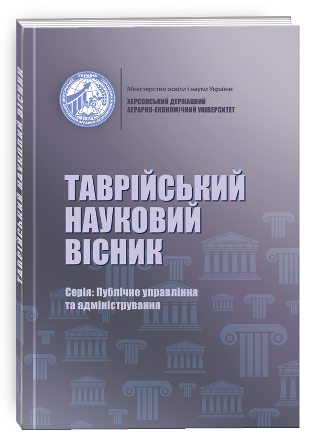JUSTIFICATION OF THE INFLUENCE FACTORS ON THE LEVEL OF COMMUNICATIVE INTERACTION OF PUBLIC ADMINISTRATION BODIES
DOI:
https://doi.org/10.32851/tnv-pub.2022.3.6Keywords:
communicative interaction, influencing factors, public administration bodies, communications, society, governmentAbstract
The article examines the main factors influencing the level of communicative interaction of public administration bodies. It is substantiated that the provision of communicative interaction is a complex dynamic process, focused on maximum interaction with the external environment and adaptation to it of the opportunities permanently inherent in the government and society. The external and internal factors that have a direct and indirect influence on the communication interaction of the government and society have been identified. It was determined that the following are the most important external factors: legal support; digitization of public services; development of electronic governance; information provision of strategic areas of state development; technological support of public administration; interactions between the authorities and mass media; budgeting and resource capabilities. Among the internal factors influencing the level of communicative interaction of public administration bodies, the following are highlighted: moral values of the authorities; transparency and openness of activities of public administration bodies; satisfaction of the population with the services provided; use of information and communication technologies; availability of a communication strategy; citizen participation and presence of public initiatives; use of modern forms and means of communication, including social networks; availability of educational programs for citizens in the field of information and communication technologies. Taking into account the identified factors of influence on the level of ensuring communicative interaction between the government and society will contribute not only to the formation of a successful constructive dialogue with the aim of ensuring the stability of the existing order, but also to a more correct justification of the corresponding communicative strategy. In addition, it will be possible to take into account restrictive and restraining measures, and to implement existing opportunities for communication between the government and society.
References
Архипова Є. О., Дмитренко Н. О. Ефективна комунікація між органами державної влади та громадськістю як умова розвитку демократичного суспільства. Інвестиції: практика та досвід. 2016. № 1. С. 92–96.
Гошовська В. А. Комунікації в публічному управлінні: аспекти організаційної культури та ділового спілкування. Київ : К.І.С., 2016. 130 с.
Дзвінчук Д. І. Комунікативна політика органів місцевого самоврядування. ІваноФранківськ : [б.в.], 2016. 129 с.
Дрешпак В. М. Комунікації в публічному управлінні. Д. : ДРІДУ НАДУ, 2015. 168 с.
Державно-громадянська комунікація: шлях від кризи до взаємодії : монографія / Козаков В. М., Рашковська О. В., Ребкало В. А. та ін. Київ : Персонал, 2017. 288 с.
Рачинська О. А. Комунікативне партнерство як механізм оптимізації комунікативної взаємодії у сфері публічного управління. Державне управління та місцеве самоврядування. 2020. Вип. 2(45). С. 135–145.
Lambin J. J., Chumpitaz R., Schuiling I. Market-Driven Management, Second Edition: Strategic and Operational Marketing. NY. : Palgrave Macmillan. 2007. 496 р.
Smorgunov L. V. In search of governability: concepts and transformation of public administration in the 21 st century. Saint Petersburg : St. Petersburg University. 2012. 362 p.







